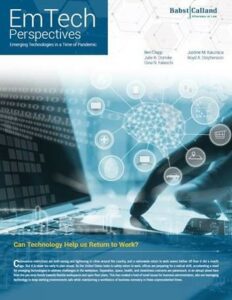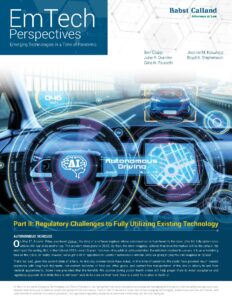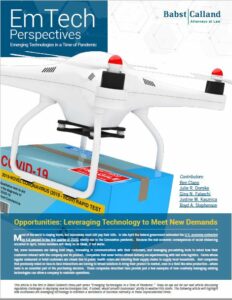 Can Technology Help Us Return to Work?
Can Technology Help Us Return to Work?
Coronavirus restrictions are both easing and tightening in cities around the country, and a nationwide return to work seems further off than it did a month ago. But it is never too early to plan ahead. As the United States looks to safely return to work, offices are preparing for a radical shift, accelerating a need for emerging technologies to address challenges in the workplace. Separation, space, health, and cleanliness concerns are paramount, in an abrupt about-face from the pre-virus trends towards flexible workspaces and open floor plans. This has created a host of novel issues for business administrators, who are leveraging technology to keep work environments safe while maintaining a semblance of business normalcy in these unprecedented times.
Read More.
 Regulatory Challenges to Fully Utilizing Existing Technology
Regulatory Challenges to Fully Utilizing Existing Technology
On May 1st, Amazon Prime premiered Upload, the story of a software engineer whose consciousness is transferred to the cloud after his fully autonomous vehicle (AV) rear-ends another car. The accident takes place in 2033. By then, the show imagines, vehicles that drive themselves will be the default. We won’t spoil the ending. But, in the fictional 2033 only 13 years from now—the public is astounded when the vehicle is involved in a wreck. It is an entertaining take on the future. In reality, however, we’ve got a lot of regulations to update if autonomous vehicles (AVs) are going to play the role imagined in Upload.
Read More.
Tags: Autonomous Vehicles,
Coronavirus,
COVID-19,
Drones,
Efficiency,
Emerging Technology,
Industry News,
Innovation,
Mobility,
Pandemic,
Robotics,
Tech Industry,
Technology,
Transportation

Opportunities: Leveraging Technology to Meet New Demands
Most of the world is staying home, but businesses must still pay their bills. In late April the federal government estimated the U.S. economy contracted by 4.8 percent in the first quarter of 2020, mostly due to the Coronavirus pandemic. Because the real economic consequences of social distancing occurred in April, future numbers will likely be as bleak, if not worse.
Yet, some businesses are taking bold steps, innovating in communications with their customers, and leveraging pre-existing tools to retool how their customers interact with the company and its product. Companies that never before offered delivery are experimenting with last mile logistics. Farms whose regular restaurant or hotel customers are closed due to public health orders are retooling their supply chains to supply local households. And companies that previously relied on face-to-face interactions are turning to virtual solutions to bring their product to market, even in a field like wine production—where taste is an essential part of the purchasing decision. These companies described here provide just a few examples of how creatively leveraging existing technologies can allow a company to maintain operations.
Read More.
Tags: Commercial,
Coronavirus,
Corporate Law,
COVID-19,
Drones,
Efficiency,
Emerging,
Emerging Technology,
Industry News,
Innovation,
Last Mile Logistics,
Logistics,
Mobility,
Pandemic,
Regulations,
Regulatory,
Remote Learning,
Robotics,
Robots,
Supply Chain,
Tech Industry,
Technology,
Transportation,
US DOT
There is global consensus that large companies across various sectors need to innovate, be agile and anticipate new technologies, new markets and new demand cycles to stay competitive.
“We are seeing a paradigmatic shift among large companies,” says Justine M. Kasznica, a shareholder at Babst Calland. “Not only are these companies seeking to attract a diverse and innovative workforce, they are pursuing business-optimizing innovation and solutions, which are often found outside their walls.”
Smart Business spoke with Kasznica about how established companies are finding and taking control of technologies that set them up for a bright future.
Read More.
Artificial intelligence (AI) is adding efficiencies and transforming businesses everywhere, and legal practices are no exception.
General counsels who are hiring lawyers need to understand that this technology is available now, so they can make sure their lawyers are leveraging the latest technology tools. AI can increase speed, increase efficiency and lower costs for clients—if the law firm has the right tools, but more importantly knows how to use those tools.
The following are some of the common questions about advancement of AI technology in the legal space.
Read More.
The trucking industry is still adjusting to the final transition to electronic logging devices (ELDs). Some relief may be on the horizon, however, as federal regulators consider whether to relax the hours of service requirements.
“Every solution has unintended consequences, and that is exactly what we are seeing now,” says Boyd A. Stephenson, associate at Babst Calland. “The supply chain is like a balloon, where everything is interconnected. You push on one part and another piece will pop out.”
Paper logbooks are left to the discretion of the driver, while ELDs record driving time automatically to ensure driving hours are strictly followed. The idea is to make the roads safer. Effective now, strict enforcement of the ELD mandate applies to all drivers, unless they operate under the short-haul rule exemption.
The trucking industry is dealing with rising transportation costs and an overall driver shortage in an economic expansion. Freight volumes also grew more slowly in 2019, with trade conflicts and tariff increases taking a toll on growth.
An American Transportation Research Institute survey found that the top industry concerns for 2019 were driver shortages, hours of service, driver compensation and detention or delays at customer facilities. These obstacles increase trucking costs, which get passed on to shippers that need their goods transported.
Smart Business spoke with Stephenson about hours of service rules and other industry changes that businesses should be aware of in 2020.
Read More.
 Babst Calland and our technology affiliate, Solvaire, have been performing complex due diligence, discovery, and document management projects for clients for more than 20 years. Our clients look to us for due diligence guidance in the areas of acquisitions and divestitures, as well as complex corporate, commercial and real estate transactions.
Babst Calland and our technology affiliate, Solvaire, have been performing complex due diligence, discovery, and document management projects for clients for more than 20 years. Our clients look to us for due diligence guidance in the areas of acquisitions and divestitures, as well as complex corporate, commercial and real estate transactions.
The firm has a long history of utilizing the latest technologies to enhance contract review. And, in the last few years, the firm has taken a deep look at AI-assisted review and its ability to enhance efficiency and reduce cost for clients. Saying that we have become “AI Believers” in the process is an understatement. After many AI tool evaluations, trials, and getting numerous AI projects under our belts, we have become our clients’ go-to resource in leveraging AI for their benefit.
Read More.
 Can Technology Help Us Return to Work?
Can Technology Help Us Return to Work? 

